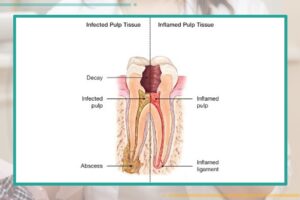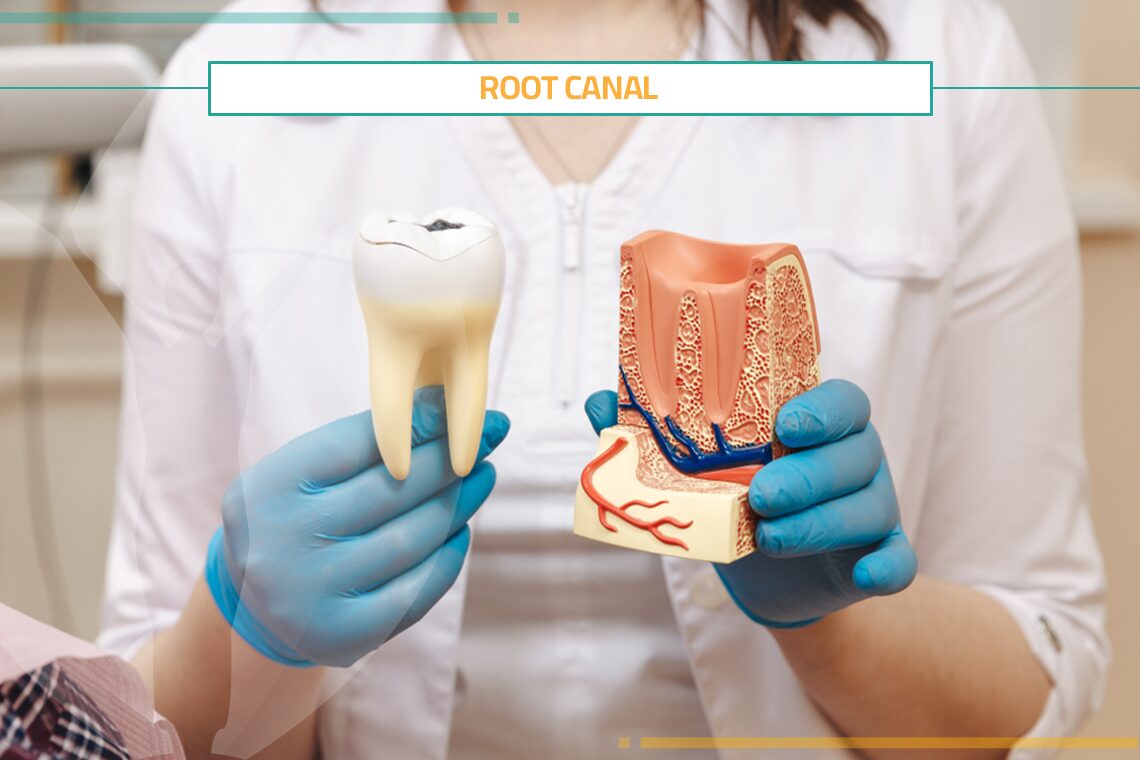Root Canal
The purpose of a Root Canal treatment is to remove diseased or inflammatory pulp from inside teeth. The tooth is then meticulously cleansed, disinfected, filled, and sealed. The goals of Root Canal Therapy are to save the normal tooth, stop the infection from spreading, and eradicate bacteria from the diseased root canal.
What Takes Place When Receiving a Root Canal Teeth Cap?
Painless process that can save your natural tooth and reduce your discomfort. If your endodontist or dentist recommends a root canal operation to treat a diseased or damaged tooth, there’s no reason to be concerned. This method of treatment and preservation restores the health of millions of teeth annually and alleviates discomfort.
Pulp is the soft tissue located inside your teeth, located beneath the hard dentin layer and the white enamel. Throughout its development, the blood arteries, nerves, and connective tissue found in this tissue aid in the growth of your tooth’s root. Because the tooth is still being fed by the tissues around it, a fully mature tooth can live without the pulp.
The Root Canal Therapy of today is very different from those proverbs! Depending on your unique situation and the state of your tooth, it may typically be finished in one or two appointments and is quite comparable to a standard filling. A root canal is a very successful and painless procedure. You’ll quickly be able to chew, bite, and smile again.
Read about Stomach Acid
Dental Structure
A tooth consists of two components. The portion of the tooth that is visible in the mouth is called the crown. The tooth is secured in place by the root, which penetrates the jaw bone.
Additionally, teeth are made up of:
- Enamel: the tooth’s hard outer layer.
- Dentine: the softer substance that constitutes the majority of the tooth and supports the enamel.
- Cementum: is a hard substance that covers the surface of the root; dental pulp is the soft tissue located in the middle of the tooth.
- The dental pulp: is located within the root canal system, which runs from the tooth’s crown to the tip of the root.
- Multiple root canals may be performed on a single tooth.

How to fix Uneven Lipo?
In What Signs Could I Be in Need of a Root Cap in Teeth?
To remove an infection from a tooth, you could require root canal therapy. Teeth infections can exist without any symptoms. Symptoms that you may experience include:
1. Persistent Tooth Ache: There are numerous causes of tooth pain. However, pain that radiates to your jaw, cheek, or other teeth, or that penetrates deeply into a tooth, may indicate an infection.
- Applying Pressure Is Painful: The nerves around your tooth pulp may have been harmed if your tooth hurts when you chew or touch it.
- Swollen Palate: You can notice tenderness or swelling in your gums if you have an infected tooth.
- A Zit on Your Gingiva: Smelly pus might seep from pimples or boils on your gums caused by infected teeth.
- Enlarged Jaw: Pus that doesn’t flow away from your infected tooth may cause your jaw to bulge.
- Teeth Discolored: An infection of the tooth pulp prevents blood from entering your tooth. Your tooth turns discolored as a result.
- A Loose Tooth: Your tooth may feel loose because the bones supporting it may become softer due to pus from an infected tooth pulp.
How Are Root Canal Treatment Crown Carried out?
The dentist will show you to a treatment room upon your arrival, assist you in settling into a chair, and put a bib over your neck to shield your clothing from stains.
Step 1: Anesthetic
A tiny bit of numbing medicine will be applied to your gums by the dentist in the vicinity of the injured tooth. Your gums will be injected with a local anesthetic after it has taken effect. It could feel like a burning or severe squeeze, but it will go away fast. Even though you won’t be feeling pain during the treatment, you will still be conscious.
Step 2: Taking out the Pulp
The endodontist or general dentist will create a little opening in the tooth’s apex once it is numb. The specialist will use special instruments called files to delicately remove the infected or damaged pulp once it is exposed. They will take extra care to thoroughly clean all of your tooth’s channels, or canals.
Step 3: Medications
To make sure the infection is eliminated and to stop it from coming back, the dentist may apply a topical antibiotic to the affected area after the pulp has been removed. The dentist will fill and seal the tooth using gutta-percha, a rubber-like substance, and sealer paste after the canals have been cleansed and disinfected. They might also recommend oral antibiotics for you.
Step 4: Filling Temporarily
The dentist will use a soft, temporary substance to seal the tooth’s small opening at the top to complete the operation. This sealant aids in preventing saliva damage to the canals.
What Takes Place in the Course of a Root Canal?
Typically, a root canal treatment takes more than one appointment. An endodontist or dentist will:
1. Obtain an x-ray of your tooth and its surrounding tissues.
2. Apply a local anesthetic to numb the region surrounding your teeth; then, to keep the area dry and clean, cover your tooth with a rubber sheet known as a dam.
3. To extract the pulp and clean and sanitize the tooth’s canals, drill a hole in the top of the tooth.
4. In case multiple sessions are required, temporarily fill your tooth with a temporary filling.
5. Following one or more appointments for the cleaning procedure, your endodontist or dentist will use gutta percha, a sterile substance, to fill the canal space.
6. Your dentist will place a filling or crown on your tooth to seal it and prevent future bacterial infection.
Everything Regarding Root Canals
Although a Root Canal, also called an endodontic treatment, is a dangerous surgery, specialists do them on a daily basis. It’s crucial to be informed about root canals before undergoing any kind of dental work.
Do Root Canal and Crown Hurt?
A root canal isn’t more unpleasant than a standard dental operation, like getting a filling or having a wisdom tooth extracted, because patients are given anesthetic. After the surgery, a root canal typically leaves the patient somewhat numb or painful, and it may even cause some minor discomfort for a few days.
How Can One Determine If They Require a Root Canal?
A severe cavity, problems from an earlier filling, or a broken tooth due to trauma or heredity all require root canal therapy. When patients realize that their teeth are sensitive, especially to hot and cold sensations, they typically require a root canal.
A few signs indicate that you may require a root canal:
- Severe discomfort when biting or chewing
- Gum acne
- A fractured or chipped tooth
- Persistent sensitivity to heat or cold, long after the initial experience has passed
inflamed or sensitive gums - Gums with severe decay or discoloration
How Much Time Does Recovery from a Root Canal Take?
Most patients can go back to work or school right away after a root canal, even though they will probably be numb for two to four hours. Eating should be avoided until the numbness goes away entirely, though.
What Is the Root Canal Teeth Cap Price?
The complexity of the issue and the tooth that is impacted determine how much it will cost. Since molars are more challenging to treat, the cost is typically higher. The majority of dental insurance plans include some endodontic treatment coverage.
The cost of endodontic therapy and restoring a natural tooth is typically lower than that of extracting the tooth. In order to restore chewing ability and stop neighboring teeth from shifting, a missing tooth must be replaced with an implant or bridge. Generally speaking, these operations are more expensive than endodontic therapy and a suitable repair.
Root Canal Treatment Complications
- Following the operation, you can have some soreness and swelling. Find out from your endodontist or dentist if you need to take painkillers.
- After, your tooth can appear darker. Though it may be vulnerable to cracking, the crown will help shield it.
What Advantages and Disadvantages Come with Having a Root Canal?
- Your tooth should no longer hurt once the root canal procedure is finished.
- Having a root canal allows you to preserve your natural tooth. Should your tooth be extracted, you could require additional care to replace it. Additionally, receiving a root canal treatment helps lessen the deterioration of your other teeth.
- Appointments for root canal therapy may last up to an hour. A local anesthetic will be required in order to ensure that you experience no pain during the process.
- Ask your endodontist or dentist how much a root canal will cost.
Root Canal Recovery
How Much Time Does Recovery from a Root Canal Take?
A root canal usually requires less than a week to heal. If your treated tooth still hurts after more than a week, give your doctor a call.
How Should I Look after Myself following a Root Canal?
During a root canal, your teeth and gums are under a lot of stress. They can heal if you:
- Consuming soft foods in the initial days following therapy. (Consider foods like yogurt, smoothies, cottage cheese, mashed potatoes, and well-cooked pasta).
- While you’re waiting on your permanent crown, try not to chew on the treated tooth.
Try to avoid smoking right after your root canal if you smoke, as this will hinder the healing process of your tooth. - Cleaning your teeth once a day and after each meal.
- Applying antimicrobial mouthwash to prevent the growth of germs.





